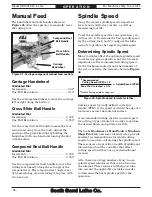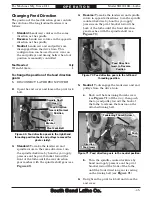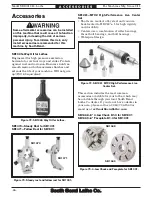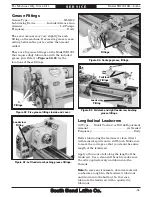
-48-
For Machines Mfg. Since 8/11
Model SB1001 8K
™
Lathe
M A I N T E N A N C E
The timing belts and pulleys should remain
free from grease and grime. Clean the
pulleys with mineral spirits when changing
configurations, then allow them to dry. Wipe
the timing belts with a clean, dry shop rag at
the same time.
Maintenance Schedule
Ongoing
To maintain a low risk of injury and proper
machine operation, if you ever observe any of the
items below, shut down the machine immediately
and fix the problem before continuing operations.
• Loose mounting bolts or fasteners.
• Worn, frayed, cracked, or damaged wires.
• Emergency STOP button not working
correctly or not requiring you to reset it
before starting the machine again.
• Loose, worn, or damaged drive belts or
timing belts.
• Damaged or malfunctioning components.
Daily, Before Operations
• Lubricate the spindle bearings (Page 49).
• Lubricate feed direction gears (Page 50).
• Lubricate grease fittings (Page 51).
• Clean/lubricate the longitudinal leadscrew
(Page 51).
• Lubricate 3-jaw chuck (Page 52).
• Clean/lubricate the bedways and slides
(Page 52).
• Check condition and tension of drive belts
(Page 55) and timing belts.
• Check for loose or damaged timing-belt
pulleys.
• Turn the spindle speed dial all the way
counterclockwise (to prevent high-speed
startup).
• Disengage the half nut lever on the apron (to
prevent crashes upon startup).
• Ensure the carriage lock is loose.
Always disconnect
machine from power before
performing maintenance or
serious personal injury may
result.
!
Daily, After Operations
• Turn the spindle switch to the OFF position,
depress the STOP button, and shut
OFF
the
master power switch (to prevent accidental
startup).
• Vacuum/clean all chips and swarf from bed,
slides, and benchtop or stand.
• Wipe down all unpainted or machined
surfaces with an lightly-oiled rag.
Annually
• Check/level bedway (Page 19).
Cleaning & Protecting
Regular cleaning is one of the most important
steps in taking care of this lathe. We recommend
that the cleaning routine be planned into the
workflow schedule, so that adequate time is set
aside to do the job right.
Typically, the easiest way to clean swarf from
the bedways and chip drawer is to use a wet/dry
shop vacuum that is dedicated for this purpose.
The small chips left over after vacuuming can
be wiped up with a lightly-oiled rag. Avoid using
compressed air to blow off chips, as it may drive
them deeper into moving surfaces and could
cause sharp chips to fly into your face or hands.
In addition to the ways, all other unpainted and
machined surfaces should be wiped down daily
to keep them rust-free and in top condition.
This includes any surface that is vulnerable
to rust (especially any parts exposed to water
soluble cutting fluid). Typically, a thin film of
good quality way oil is all that is necessary for
protection. (Refer to Accessories on Page 46 for
an option from South Bend.)


































